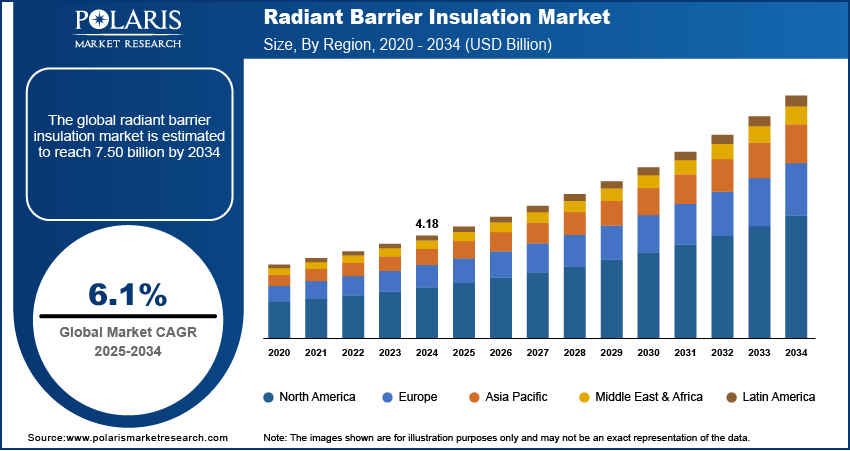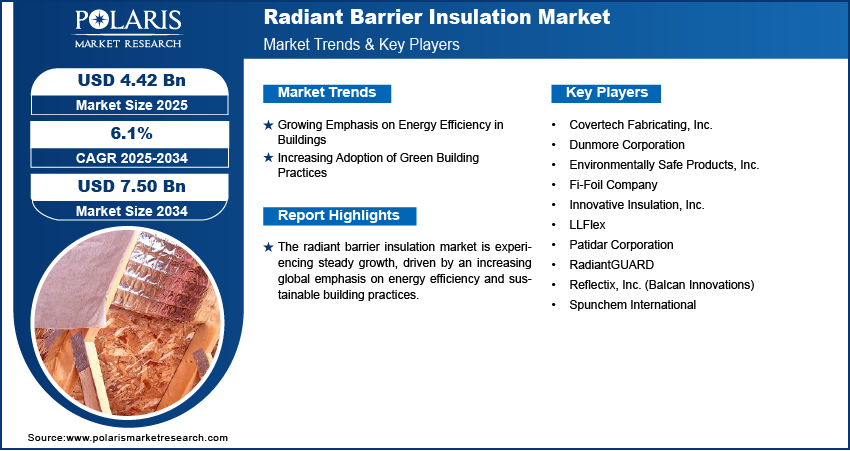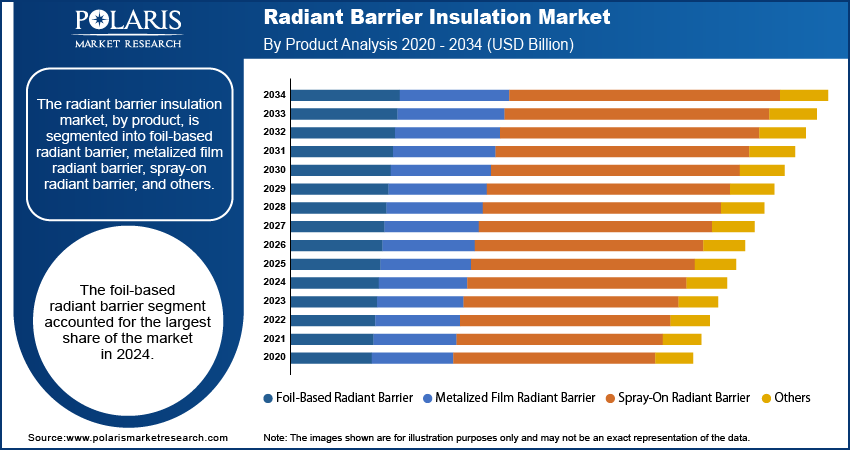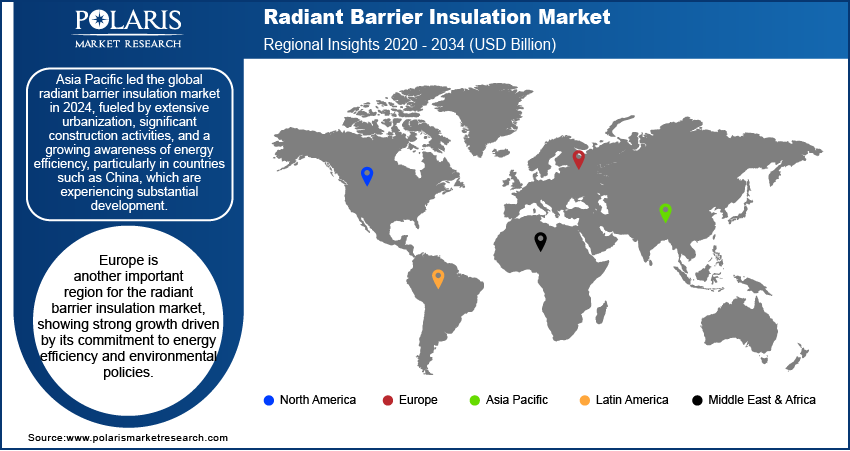
Radiant Barrier Insulation Market Size, Share, Trends, & Industry Analysis Report
By Product (Foil-Based Radiant Barrier, Metalized Film Radiant Barrier, Spray-On Radiant Barrier, and Others), By End Use, By Region – Market Forecast, 2025–2034
- Published Date:Jun-2025
- Pages: 125
- Format: PDF
- Report ID: PM5805
- Base Year: 2024
- Historical Data: 2020-2023
Market Overview
The global radiant barrier insulation market size was valued at USD 4.18 billion in 2024 and is anticipated to register a CAGR of 6.1% from 2025 to 2034. The increasing demand for energy-efficient building solutions, especially in residential and commercial sectors, is driving the market growth. Rising energy costs and a growing awareness of environmental sustainability also propel the demand for radiant barrier insulation.
Radiant barrier insulation is a building material designed to reduce heat transfer by reflecting radiant heat. It usually consists of a highly reflective surface, typically made of aluminum foil, that is applied to a substrate. This material works by blocking radiant heat from entering or leaving a building, helping to maintain indoor temperatures.

A significant driver for the radiant barrier insulation market is the growing emphasis on energy efficiency in buildings. With rising global energy consumption and concerns about climate change, there is an increasing push for solutions that can reduce energy use in residential and commercial structures. Radiant barriers offer a way to achieve this by significantly reducing the need for heating and cooling, leading to lower utility bills.
Another major driver is the increasing demand for sustainable and eco-friendly construction practices. As environmental awareness grows, consumers and building professionals seek materials that contribute to a smaller carbon footprint. Radiant barrier insulation aligns with this trend by reducing the energy required for climate control, thereby lessening the adverse environmental impact of buildings. For instance, the US Department of Energy highlights that radiant barriers effectively reduce summer heat gain, lowering cooling costs and potentially allowing for smaller air conditioning systems. This directly supports energy conservation goals and aligns with broader sustainability initiatives.
Industry Dynamics
Growing Emphasis on Energy Efficiency in Buildings
The increasing global focus on energy efficiency in both new construction and existing buildings is a major driver. As energy costs continue to climb and concerns about environmental impact grow, there is a strong push towards reducing energy consumption in residential, commercial, and industrial sectors. Radiant barriers directly address this need by significantly minimizing heat transfer, thus lowering the demand for heating and cooling systems.
Government initiatives and building codes worldwide are increasingly promoting energy-efficient solutions, boosting the adoption of radiant barriers. For example, according to a US Department of Energy (DOE) article titled “Department of Energy's “Radiant Barriers”published in 2025, radiant barriers can reduce cooling costs by 5% to 10% in warm, sunny climates when used in home. Moreover, experiments in Florida have shown summer heat gain through the roof can be reduced by as much as 40%. This direct impact on energy savings makes radiant barriers attractive for property owners and developers striving to meet energy efficiency goals.
Increasing Adoption of Green Building Practices
The rise of global sustainable and green building practices is another significant driver. As awareness about climate change and the environmental footprint of buildings increases, there is a growing demand for construction materials and methods that support sustainability. Green building standards often prioritize materials that reduce energy consumption and environmental impact, making radiant barriers suitable.
Radiant barrier insulation contributes to green building by reducing the overall energy demand of a structure, which reduces greenhouse gas emissions associated with power generation. As per an MDPI article published in 2024, for Sustainable Building Materials, highlights that buildings consume a substantial share of global energy, primarily for heating and cooling, and that effective thermal insulation is fundamental to enhancing energy efficiency and mitigating environmental impact. The ability of radiant barriers to reflect heat aligns with the goals of reducing energy consumption and carbon footprint in green buildings.

Segmental Insights
By Product
The foil-based radiant barrier segment held the largest share of approximately 53% in 2024. This dominance is primarily attributed to its proven effectiveness, cost-efficiency, and widespread acceptance in various building applications. These barriers, typically made from aluminum foil laminated onto materials such as kraft paper or plastic films, offer superior reflectivity, crucial for blocking radiant heat. Their ease of installation in attics, walls, and roofs has also contributed to their popularity.
The metalized film radiant barrier segment is anticipated to register the highest growth rate during the forecast period. This growth can be attributed to advancements in material science and increasing demand for improved durability and performance in specific applications. Metalized films, where a thin layer of metal is deposited onto a polymer film, offer enhanced mechanical strength and moisture resistance compared to some traditional foil-based options. These characteristics make them well-suited for demanding environments and specialized construction projects where longevity and resilience are key. Furthermore, the push toward more advanced and sustainable building solutions is boosting the adoption of these innovative films.
By End Use
The residential segment held the largest share of the market in 2024, primarily driven by homeowners' increasing awareness of energy savings, the desire for improved indoor comfort, and the rising cost of utilities. Radiant barriers are widely adopted in homes, particularly attics and roofs, to combat heat gain during warmer months and reduce the load on air conditioning systems. The ease of installation in new residential constructions and retrofit projects further contributes to this segment's dominance.
The commercial segment is anticipated to register the highest growth rate during the forecast period. This accelerated growth is fueled by a rising focus on energy efficiency in commercial buildings, which include offices, retail spaces, warehouses, and institutional structures. Businesses increasingly recognize the long-term economic benefits of reducing energy consumption and the desire to meet sustainability goals and comply with evolving building codes. Radiant barriers effectively manage indoor temperatures and help in high-temperature insulation in large commercial spaces, lowering HVAC operational costs.

Regional Analysis
The Asia Pacific radiant barrier insulation market dominated with the largest revenue share in 2024. This is primarily fueled by rapid urbanization, extensive infrastructure development, and increasing construction activities, especially in developing economies within the region. As energy costs rise and environmental concerns become more prominent, there is a growing recognition among builders and consumers about the benefits of energy-efficient building materials. The China radiant barrier insulation market holds a major share in Asia Pacific. Its immense population and massive ongoing construction projects in residential, commercial, and industrial sectors generate substantial demand for insulation products. The Chinese government's focus on sustainable development and energy conservation in its urban planning and building initiatives, including building thermal insulation, further boosts the adoption of radiant barriers. Reducing cooling loads in hot and humid urban environments also contributes to increasing demand across Asia Pacific.
North America Radiant Barrier Insulation Market
North America represents a significant share of the radiant barrier insulation industry. A combination of factors, including high energy consumption in residential and commercial buildings and a strong focus on energy efficiency, largely influences the region's demand. Stringent building codes, regulations, and government incentives for green building practices and energy-efficient homes also drive the adoption of radiant barriers. Additionally, the prevalence of hot and humid climates in certain parts of North America, such as the southern US, creates a strong need for solutions that reduce cooling loads and improve indoor comfort.
US Radiant Barrier Insulation Market Insight
The US is a major contributor to the North America radiant barrier insulation market. The country's varied climate, particularly the high air-conditioning usage in its southern states such as Texas, Florida, and California, creates a substantial demand for heat-reflective solutions. Rising energy bills and a growing consumer awareness about the long-term benefits of energy-efficient products further drive market growth. The US market is also characterized by a robust home improvement sector, with numerous retrofitting projects aiming to upgrade existing structures with better insulation. Government support through various programs and tax incentives for energy-efficient upgrades encourages the use of radiant barriers across residential and commercial applications.
Europe Radiant Barrier Insulation Market
Europe is another important region for the radiant barrier insulation market, showing strong growth driven by its commitment to energy efficiency and environmental policies. The European Union has implemented rigorous building directives to reduce energy consumption and carbon emissions, directly promoting advanced insulation materials such as radiant barriers. The emphasis on sustainable construction practices and the increasing adoption of near-zero-energy buildings across the region are key factors propelling demand. The Germany radiant barrier insulation market strongly focuses on sustainability and energy efficiency in its construction industry, making it a leading adopter of reflective insulation solutions. Germany's robust industrial sector contributes to the demand for specialized insulation in various applications. The ongoing efforts to enhance energy performance in both new and renovated buildings, supported by national policies and public awareness, ensure a steady demand for radiant barrier insulation in Germany and Europe.

Key Players and Competitive Insights
A mix of established global players and specialized regional manufacturers characterizes the competitive landscape of the radiant barrier insulation market. Companies actively engage in product innovation, enhancing performance, durability, and ease of installation. There is also a strong emphasis on developing sustainable and environmentally friendly solutions to meet evolving market demands and regulatory requirements.
A few prominent companies in the industry include Reflectix, Inc.; Innovative Insulation, Inc.; Fi-Foil Company; Covertech Fabricating, Inc.; RadiantGUARD; LLFlex; Environmentally Safe Products, Inc.; Patidar Corporation; Spunchem International; and Dunmore Corporation.
Key Players
- Covertech Fabricating, Inc.
- Dunmore Corporation
- Environmentally Safe Products, Inc.
- Fi-Foil Company
- Innovative Insulation, Inc.
- LLFlex
- Patidar Corporation
- RadiantGUARD
- Reflectix, Inc. (Balcan Innovations)
- Spunchem International
Industry Developments
April 2024: Dunmore Corporation announced a partnership with ICEYE for multilayer insulation films. This collaboration highlights Dunmore's role in providing specialized film solutions, including those with insulation properties, for advanced applications such as spacecraft.
November 2022: Fi-Foil acquired Kennedy Insulation Group. This move greatly expanded FI-FOIL's product line for reflective insulation.
Radiant Barrier Insulation Market Segmentation
By Product Outlook (Revenue – USD Billion, 2020–2034)
- Foil-Based Radiant Barrier
- Metalized Film Radiant Barrier
- Spray-On Radiant Barrier
- Others
By End Use Outlook (Revenue – USD Billion, 2020–2034)
- Residential
- Commercial
- Industrial
By Regional Outlook (Revenue – USD Billion, 2020–2034)
- North America
- US
- Canada
- Europe
- Germany
- France
- UK
- Italy
- Spain
- Netherlands
- Russia
- Rest of Europe
- Asia Pacific
- China
- Japan
- India
- Malaysia
- Suth Korea
- Indnesia
- Australia
- Vietnam
- Rest of Asia Pacific
- Middle East & Africa
- Saudi Arabia
- UAE
- Israel
- Suth Africa
- Rest of Middle East & Africa
- Latin America
- Mexic
- Brazil
- Argentina
- Rest of Latin America
Radiant Barrier Insulation Market Report Scope:
|
Report Attributes |
Details |
|
Market Size in 2024 |
USD 4.18 billion |
|
Market Size in 2025 |
USD 4.42 billion |
|
Revenue Forecast by 2034 |
USD 7.50 billion |
|
CAGR |
6.1% from 2025 to 2034 |
|
Base Year |
2024 |
|
Historical Data |
2020–2023 |
|
Forecast Period |
2025–2034 |
|
Quantitative Units |
Revenue in USD billion and CAGR from 2025 to 2034 |
|
Report Coverage |
Revenue Forecast, Competitive Landscape, Growth Factors, and Industry Insights |
|
Segments Covered |
|
|
Regional Scope |
|
|
Competitive Landscape |
|
|
Report Format |
|
|
Customization |
Report customization as per your requirements concerning countries, regions, and segmentation. |
FAQ's
The global market size was valued at USD 4.18 billion in 2024 and is projected to grow to USD 7.50 billion by 2034.
The global market is projected to register a CAGR of 6.1% during the forecast period.
Asia Pacific dominated the market share in 2024.
A few key players in the market include Reflectix, Inc.; Innovative Insulation, Inc.; Fi-Foil Company; Covertech Fabricating, Inc.; RadiantGUARD; LLFlex; Environmentally Safe Products, Inc.; Patidar Corporation; Spunchem International; and Dunmore Corporation.
The foil-based radiant barrier segment accounted for the largest share of the market in 2024.
The metalized film radiant barrier segment is expected to grow fastest during the forecast period.
